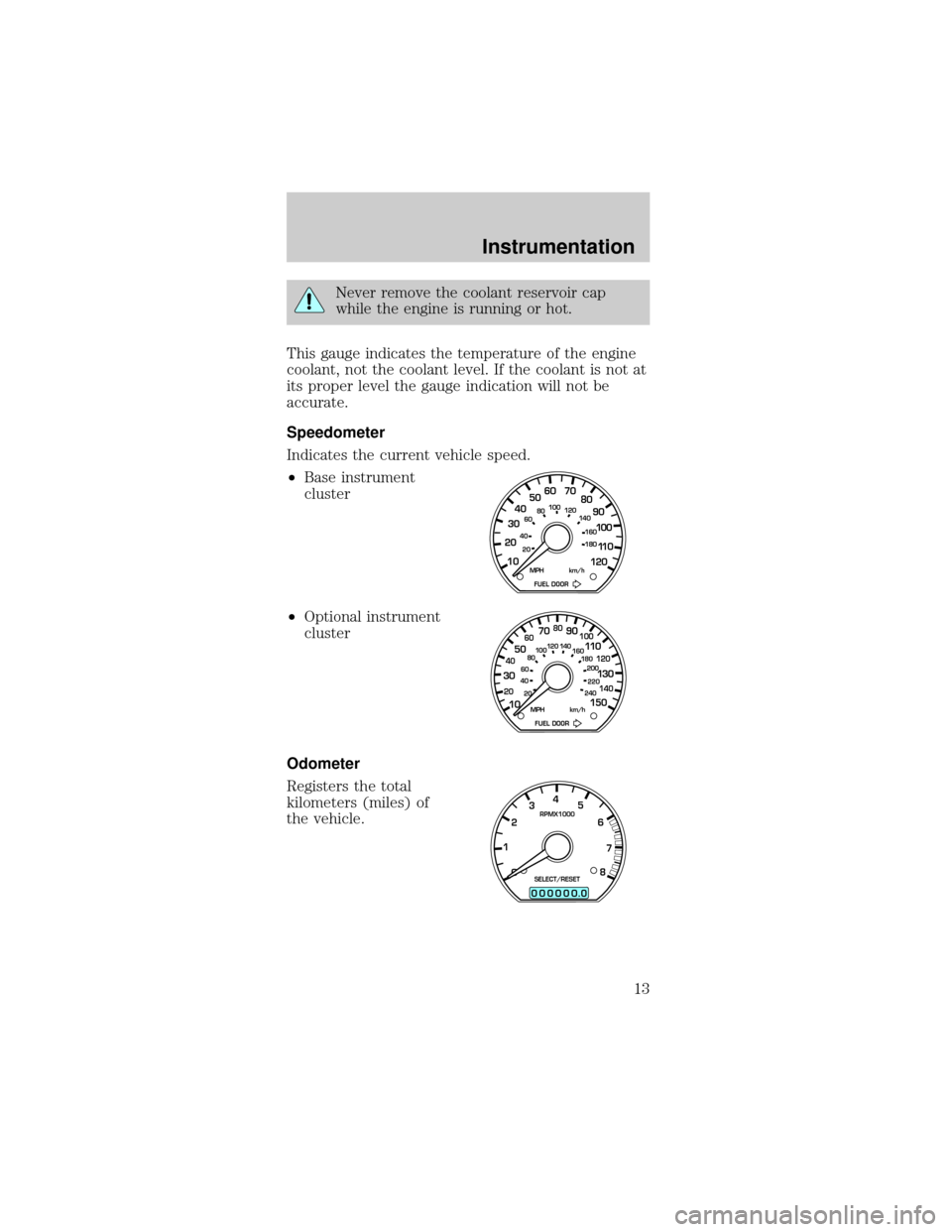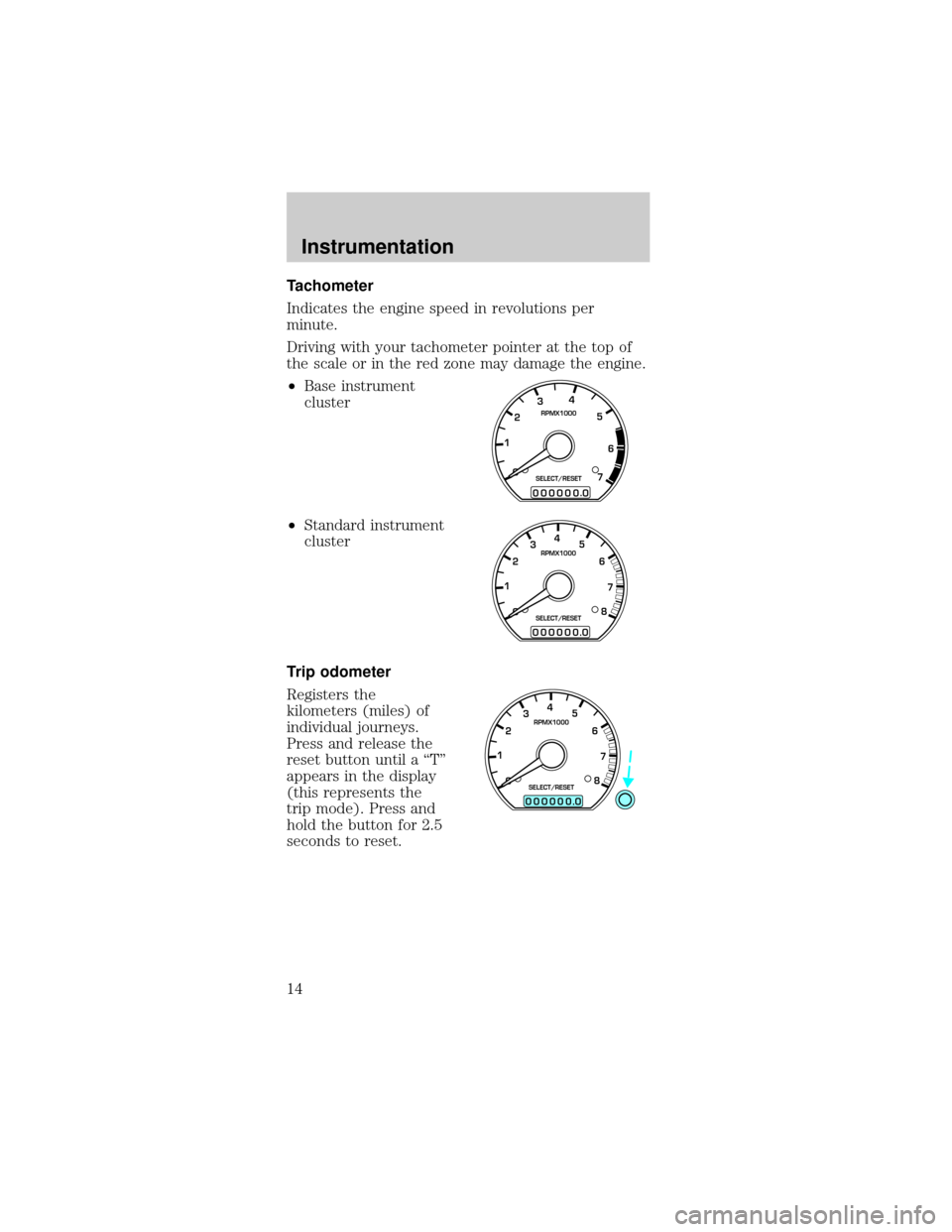odometer FORD MUSTANG 1999 4.G Owners Manual
[x] Cancel search | Manufacturer: FORD, Model Year: 1999, Model line: MUSTANG, Model: FORD MUSTANG 1999 4.GPages: 216, PDF Size: 1.72 MB
Page 13 of 216

Never remove the coolant reservoir cap
while the engine is running or hot.
This gauge indicates the temperature of the engine
coolant, not the coolant level. If the coolant is not at
its proper level the gauge indication will not be
accurate.
Speedometer
Indicates the current vehicle speed.
²Base instrument
cluster
²Optional instrument
cluster
Odometer
Registers the total
kilometers (miles) of
the vehicle.
10 203020 406080100
120
140
160
180
405060 70
80
90
100
11 0
120
FUEL DOOR MPH km/h
102040608020 40608010 012 0 14 0
160
180
200
220
240
100
120
140
305070 90
110
13 0
150
FUEL DOOR MPH km/h
0
00000 00
4
5
6
7
8 3
2
1RPMX1000
SELECT/RESET
.
Instrumentation
13
Page 14 of 216

Tachometer
Indicates the engine speed in revolutions per
minute.
Driving with your tachometer pointer at the top of
the scale or in the red zone may damage the engine.
²Base instrument
cluster
²Standard instrument
cluster
Trip odometer
Registers the
kilometers (miles) of
individual journeys.
Press and release the
reset button until a ªTº
appears in the display
(this represents the
trip mode). Press and
hold the button for 2.5
seconds to reset.
0
00000 00
4
5
6
7 3
2
1RPMX1000
SELECT/RESET
.
0
00000 00
4
5
6
7
8 3
2
1RPMX1000
SELECT/RESET
.
0
00000 00
4
5
6
7
8 3
2
1RPMX1000
SELECT/RESET
.
Instrumentation
14
Page 165 of 216

²Use a known quality gasoline, preferably a
national brand.
²Use the same side of the same pump and have
the vehicle facing the same direction each time
you fill up.
²Have the vehicle loading and distribution the
same every time.
Your results will be most accurate if your filling
method is consistent.
Calculating fuel economy
1. Fill the fuel tank completely and record the initial
odometer reading (in kilometers or miles).
2. Each time you fill the tank, record the amount of
fuel added (in liters or gallons).
3. After at least three to five tank fill-ups, fill the
fuel tank and record the current odometer reading.
4. Subtract your initial odometer reading from the
current odometer reading.
5. Follow one of the simple calculations in order to
determine fuel economy:
Multiply liters used by 100, then divide by total
kilometers traveled.
Divide total miles traveled by total gallons
used.
Keep a record for at least one month and record the
type of driving (city or highway). This will provide
an accurate estimate of the vehicle's fuel economy
under current driving conditions. Additionally,
keeping records during summer and winter will show
how temperature impacts fuel economy. In general,
lower temperatures give lower fuel economy.
Maintenance and care
165
Page 194 of 216

general manager of the dealership. In most cases,
your concern will be resolved at this level.
Ford Motor Company and Ford of Canada
dealerships also carry genuine Ford parts and
accessories, providing you with original equipment
reliability.
Away from home
If you are away from home when your vehicle needs
service, or if you need more help than the dealership
could provide, contact the Ford Customer Assistance
Center to find an authorized dealership to help you.
In the United States:
Ford Motor Company
Customer Assistance Center
16800 Executive Plaza Drive
P.O. Box 6248
Dearborn, Michigan 48121
1-800-392-3673 (FORD)
(TDD for the hearing impaired: 1-800-232-5952)
In Canada:
Customer Assistance Centre
Ford Motor Company of Canada, Limited
P.O. Box 2000
Oakville, Ontario L6J 5E4
1-800-565-3673 (FORD)
Please have the following information available when
contacting Ford Customer Assistance:
²Your telephone number (home and business)
²The name of the dealer and the city where the
dealership is located
²The year and make of your vehicle
²The date of vehicle purchase
²The current odometer reading
²The vehicle identification number (VIN)
Customer assistance
194
Page 209 of 216

Fluid capacities ....... 183
Foglamps ................... 53
Fuel .......................... 158
calculating fuel
economy ................ 164
cap ......................... 161
capacity ................. 183
choosing
the right fuel ......... 162
comparisons with
EPA fuel economy
estimates ............... 168
detergent in fuel ... 163
filling your vehicle
with fuel .. 158,161,164
filter,
specifications . 163,182
fuel pump shut-off
switch .................... 112
gauge ....................... 12
improving fuel
economy ................ 164
low fuel
warning light ............. 9
octane rating .. 162,188
quality .................... 162
running
out of fuel ............. 163
safety information
relating to
automotive fuels ... 158
Fuses ................. 113,114
Gas cap
(see Fuel cap) ......... 161
Gas mileage(see
Fuel economy) ........ 164
Gauges .................. 11,12
battery voltage
gauge ....................... 15
engine coolant
temperature gauge . 12engine oil pressure
gauge ....................... 15
fuel gauge ................ 12
odometer ................. 13
speedometer ........... 13
tachometer .............. 14
trip odometer .......... 14
GAWR (Gross Axle
Weight Rating) ........ 106
definition ............... 106
driving with
a heavy load .......... 106
location .................. 106
GVWR (Gross Vehicle
Weight Rating) ........ 106
calculating ............. 106
definition ............... 106
driving with
a heavy load .......... 106
location .................. 106
Hazard flashers ....... 112
Head restraints ......... 64
Headlamps ................. 16
aiming ............. 175,176
bulb
specifications ........ 175
daytime
running lights .......... 16
flash to pass ............ 45
high beam ............ 7,45
turning on and off .. 16
warning chime ........ 11
Heating ...................... 18
heating and air
conditioning
system ..................... 18
Hood ........................ 132
Ignition ..................... 188
positions of the
ignition .................... 45
removing the key .. 105
Index
209
Page 210 of 216

Infant seats
(see Safety seats) ..... 81
Inspection/maintenance
(I/M) testing ............ 169
Instrument panel ........ 6
cleaning ................. 180
lighting up panel
and interior ............. 17
location of
components ............... 6
Jump-starting your
vehicle ...................... 123
Keys
key in ignition
chime ....................... 11
positions of the
ignition .................... 45
removing from the
ignition .................. 105
Lamps
cargo lamps ............. 17
daytime
running light ........... 16
fog lamps ................. 53
headlamps ........ 16,171
headlamps,
flash to pass ............ 45
instrument panel,
dimming ................... 17
interior lamps ......... 50
174,175
replacing
bulbs ............... 170,171
172,173,174
Lane change indicator
(see Turn signal) ...... 44
Lights, warning and
indicator ...................... 6
air bag ........................ 7
anti-lock brakes
(ABS) ................. 10,93
anti-theft ................... 7brake ........................ 10
charging system ........ 7
check coolant .......... 10
high beam ................. 7
low fuel ...................... 9
overdrive off .............. 9
safety belt ................. 7
service engine soon .. 8
traction
control active .......... 10
turn signal
indicator .................... 6
Load limits ............... 106
GAWR .................... 106
GVWR .................... 106
trailer towing ........ 106
Locks
doors ........................ 51
Lubricant
specifications .... 185,188
Lumbar support,
seats ........................... 66
Manual
transmission ............ 102
fluid capacities ...... 183
lubricant
specifications ........ 188
reverse ................... 104
Mirrors
side view mirrors
(power) ................... 51
Motorcraft
parts .................. 163,182
Octane rating .......... 162
Odometer ................... 13
Panic alarm feature,
remote entry
system ........................ 58
Parking brake ............ 94
Parts (see
Motorcraft parts) .... 182
Index
210
Page 212 of 216

Traction control ........ 95
active light .............. 10
Traction-lok
rear axle .................. 105
Transmission
automatic
operation ................. 97
fluid, checking
and adding
(automatic) ........... 146
fluid, checking and
adding (manual) ... 149
fluid,
refill capacities ...... 183
lubricant
specifications ........ 188
manual operation .. 102
Trip odometer ........... 14
Trunk
remote release ... 44,58
Turn signal ............. 6,44
Vehicle dimensions . 188
Vehicle Identification
Number (VIN) ......... 190Vehicle loading ........ 106
Ventilating
your vehicle ............... 91
Warning chimes ......... 11
Warning lights
(see Lights) ................. 6
Washer fluid ............ 140
Water,
Driving through ....... 111
Wheels
anti-theft
lug nuts ................. 123
Windows
power ....................... 50
Windshield washer
fluid and wipers
checking
and cleaning .......... 152
operation ................. 44
replacing
wiper blades .......... 153
Wrecker towing ....... 128
Index
212